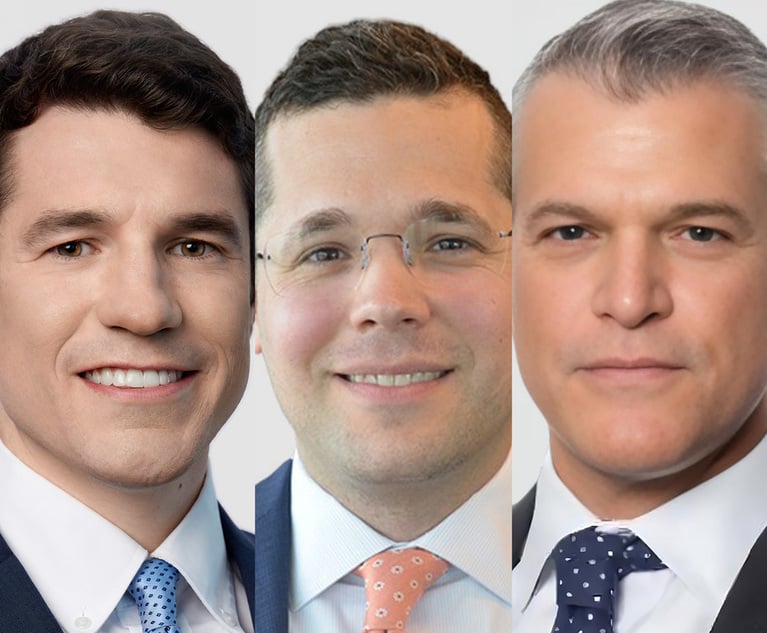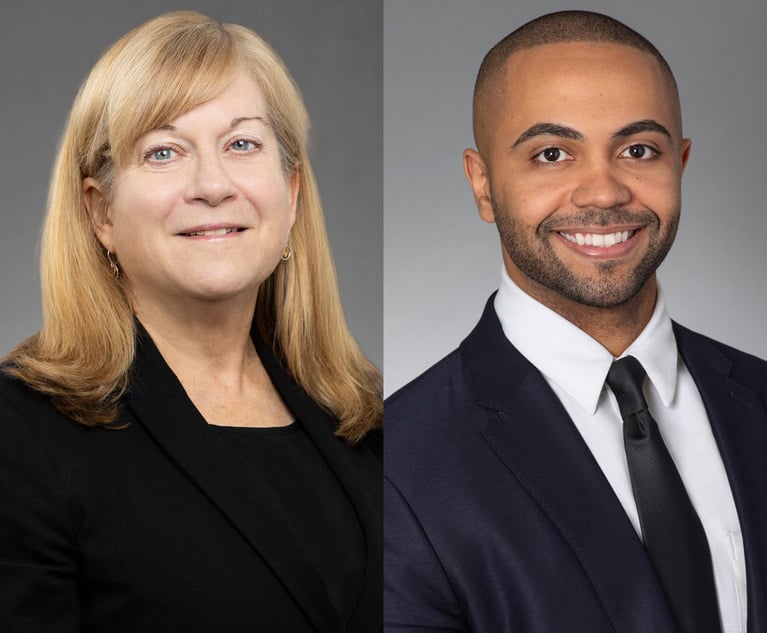 Samuel Lewis Member Cozen O'Connor Miami
Samuel Lewis Member Cozen O'Connor MiamiStairway to Heaven: End of the Inverse Ratio Rule Apophthegm
Perhaps the thing I love most about intellectual property law is that it deals with the intellectual pursuits that make life worth living: music, art, literature, technology and science.
March 16, 2020 at 12:15 PM
5 minute read
Perhaps the thing I love most about intellectual property law is that it deals with the intellectual pursuits that make life worth living: music, art, literature, technology and science. No other area of law could combine what has been described as the "greatest rock song of all time" and the question of whether that song infringes the rights of the author of an earlier musical composition. That, however, is precisely the issue the U.S. Court of Appeals for the Ninth Circuit decided on March 9 in a case involving the Led Zeppelin rock masterpiece "Stairway to Heaven."
In 2014, nearly 40 years after Led Zeppelin released "Stairway," the estate of Randy Wolfe—a guitarist from the band Spirit who performed under the moniker "Randy California"—sued Led Zeppelin, its members Jimmy Page, Robert Plant and John Paul Jones, and various other music industry companies, claiming that the song had been copied from an instrumental song written in 1966 or 1967 called "Taurus."
The "Stairway" case itself involves so many issues, including the interplay of two major copyright acts in the United States, it could easily pass for a law school exam question.
If you have access to a music streaming service, you can listen to one of the various Spirit recordings of "Taurus," although listening to the recordings may give you the wrong impression. Since music recordings were not protectable under the 1909 Copyright Act (the major enactment prior to the current 1976 Act), only the musical composition itself could be claimed. In the case of "Taurus," the musical composition registered with the Copyright Office consists of only one page of music, and far less than what was ultimately included in Spirit's recordings.
After a five-day trial, which included testimony from two expert musicologists, the jury returned a verdict in favor of Led Zeppelin. According to the verdict, Led Zeppelin had access to "Taurus"—Page even admitted that he owned a copy of the Spirit album that included "Taurus"—but the songs were not substantially similar. Apparently, the jury did not believe one of the experts, who focused on three two-note sequences that appear in both compositions, instead believing the other expert who explained that any similarity in the three two-note sequences were not "musically significant" because the sequences "were preceded and followed by different notes to form distinct melodies."
Wolfe's estate appealed to the U.S. Court of Appeals for the Ninth Circuit, which first reversed the jury verdict, and then reviewing the case en banc, affirmed the jury verdict.
|End of the Inverse Ratio Rule?
One of the more significant aspects of the "Stairway" case involves the Ninth Circuit's abrogation of the "inverse ratio rule," a concept that the court itself first articulated in a 1977 opinion.
Federal appeals courts are presently divided when it comes to recognizing or rejecting the inverse ratio rule, with the majority (the courts of appeals for the Second, Fifth, Seventh and Eleventh Circuits) having rejected it. Only the Sixth and Ninth Circuits had endorsed the rule.
In order to prevail in a copyright infringement action, the copyright owner must prove that the infringer copied protectable aspects of the owner's work. When dealing with certain types of copyrightable works—such as a photograph or other artwork—this concept is relatively straightforward. However, when dealing with other types of works—including musical compositions—proving infringement can be particularly challenging. In many of the more prominent cases involving musical compositions, the accused artists have defended on the grounds that they independently created their music without borrowing from the copyright owner's composition. Because of this, courts employ the access/substantial similarity test, which considers whether a defendant had access to the copyrighted work, and if so, whether the defendant's work is substantially similar to the protectable elements of the copyrighted work.
The inverse ratio rule was intended to complement the access/substantial similarity test by reducing the amount of proof of substantial similarity needed if a copyright owner could establish a high degree of access to the copyrighted work. As originally expressed by the Ninth Circuit in 1977, a showing of a high "degree of access … justified a lower standard of proof to show substantial similarity." Application of the rule, however, has been so confusing as to draw criticism.
Other circuit courts have been critical of the inverse ratio rule. The Second Circuit rejected the concept in 1961, describing it as a "superficially attractive apophthegm which upon examination confuses more than it clarifies."
William Patry, author of a copyright treatise, suggests that "the inverse ratio theory confuses fundamental principles of infringement analysis: access is relevant only in establishing the act of copying, not in establishing the degree thereof." Going further, Patry wrote that "[t]here is nothing positive that can be said about a rule that lacks any clarity at all: trying to get a jury to both understand the rule and apply it properly is totally impossible."
With the "Stairway" decision, the Ninth Circuit has now joined the majority of appeals courts in rejecting the inverse ratio rule.
|Stairway's Next Step?
Since there is still a split in the circuit courts over the viability of the inverse ratio rule, Wolfe's estate could seek to have the Supreme Court review the case. However, with the Ninth Circuit now joining the majority of circuits, it seems far more likely that the songs will close this chapter in their history.
Samuel Lewis is board certified in intellectual property law and the co-chair of copyright practice at Cozen O'Connor in Miami, Florida. He can be reached at [email protected].
This content has been archived. It is available through our partners, LexisNexis® and Bloomberg Law.
To view this content, please continue to their sites.
Not a Lexis Subscriber?
Subscribe Now
Not a Bloomberg Law Subscriber?
Subscribe Now
NOT FOR REPRINT
© 2024 ALM Global, LLC, All Rights Reserved. Request academic re-use from www.copyright.com. All other uses, submit a request to [email protected]. For more information visit Asset & Logo Licensing.
You Might Like
View All

As a New Year Dawns, the Value of Florida’s Revised Mediation Laws Comes Into Greater Focus
4 minute read
Data Breaches, Increased Regulatory Risk and Florida’s New Digital Bill of Rights
7 minute read
Navigating Florida's Products Liability Law: Defective Products, Warnings and the Pursuit of Justice
6 minute readLaw Firms Mentioned
Trending Stories
- 1It's Time To Limit Non-Competes
- 2Jimmy Carter’s 1974 Law Day Speech: A Call for Lawyers to Do the Public Good
- 3Second Circuit Upholds $5M Judgment Against Trump in E. Jean Carroll Case
- 4Clifford Chance Hikes Partner Pay as UK Firms Fight to Stay Competitive on Compensation
- 5Judicial Conduct Watchdog Opposes Supreme Court Justice's Bid to Withdraw Appeal of Her Removal
Who Got The Work
Michael G. Bongiorno, Andrew Scott Dulberg and Elizabeth E. Driscoll from Wilmer Cutler Pickering Hale and Dorr have stepped in to represent Symbotic Inc., an A.I.-enabled technology platform that focuses on increasing supply chain efficiency, and other defendants in a pending shareholder derivative lawsuit. The case, filed Oct. 2 in Massachusetts District Court by the Brown Law Firm on behalf of Stephen Austen, accuses certain officers and directors of misleading investors in regard to Symbotic's potential for margin growth by failing to disclose that the company was not equipped to timely deploy its systems or manage expenses through project delays. The case, assigned to U.S. District Judge Nathaniel M. Gorton, is 1:24-cv-12522, Austen v. Cohen et al.
Who Got The Work
Edmund Polubinski and Marie Killmond of Davis Polk & Wardwell have entered appearances for data platform software development company MongoDB and other defendants in a pending shareholder derivative lawsuit. The action, filed Oct. 7 in New York Southern District Court by the Brown Law Firm, accuses the company's directors and/or officers of falsely expressing confidence in the company’s restructuring of its sales incentive plan and downplaying the severity of decreases in its upfront commitments. The case is 1:24-cv-07594, Roy v. Ittycheria et al.
Who Got The Work
Amy O. Bruchs and Kurt F. Ellison of Michael Best & Friedrich have entered appearances for Epic Systems Corp. in a pending employment discrimination lawsuit. The suit was filed Sept. 7 in Wisconsin Western District Court by Levine Eisberner LLC and Siri & Glimstad on behalf of a project manager who claims that he was wrongfully terminated after applying for a religious exemption to the defendant's COVID-19 vaccine mandate. The case, assigned to U.S. Magistrate Judge Anita Marie Boor, is 3:24-cv-00630, Secker, Nathan v. Epic Systems Corporation.
Who Got The Work
David X. Sullivan, Thomas J. Finn and Gregory A. Hall from McCarter & English have entered appearances for Sunrun Installation Services in a pending civil rights lawsuit. The complaint was filed Sept. 4 in Connecticut District Court by attorney Robert M. Berke on behalf of former employee George Edward Steins, who was arrested and charged with employing an unregistered home improvement salesperson. The complaint alleges that had Sunrun informed the Connecticut Department of Consumer Protection that the plaintiff's employment had ended in 2017 and that he no longer held Sunrun's home improvement contractor license, he would not have been hit with charges, which were dismissed in May 2024. The case, assigned to U.S. District Judge Jeffrey A. Meyer, is 3:24-cv-01423, Steins v. Sunrun, Inc. et al.
Who Got The Work
Greenberg Traurig shareholder Joshua L. Raskin has entered an appearance for boohoo.com UK Ltd. in a pending patent infringement lawsuit. The suit, filed Sept. 3 in Texas Eastern District Court by Rozier Hardt McDonough on behalf of Alto Dynamics, asserts five patents related to an online shopping platform. The case, assigned to U.S. District Judge Rodney Gilstrap, is 2:24-cv-00719, Alto Dynamics, LLC v. boohoo.com UK Limited.
Featured Firms
Law Offices of Gary Martin Hays & Associates, P.C.
(470) 294-1674
Law Offices of Mark E. Salomone
(857) 444-6468
Smith & Hassler
(713) 739-1250






